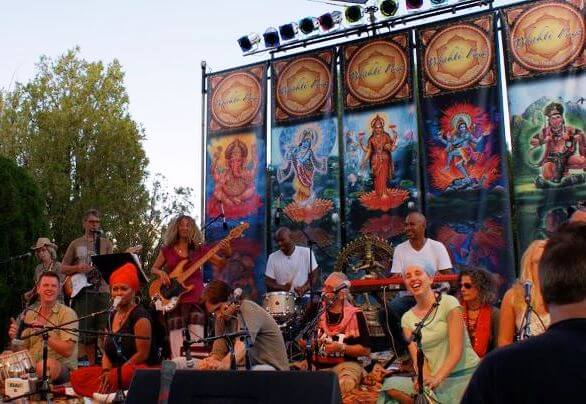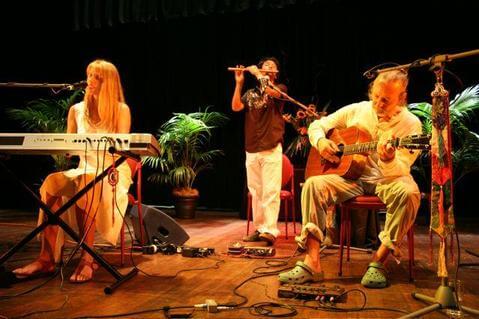Oct 25 - Oct 27, 2024
You Can Heal Childhood PTSD
Reconnect–emotionally and intimately–with your inner femininity.


Yoga is on fire in the West, and so it kirtan, or yogic chanting. Kirtan combines music and mantra — words and sounds that vibrate at the highest level of awareness. It is an effortless and joyful way to meditate. You simply let the music and mantra do the work for you.
Kirtan is a different kind of concert-going experience. It’s not so much a performance as it is a journey into the Self — through the practice of listening & singing. While singing along at a kirtan event, you can find your own voice and become one voice with those performing.
For those who find seated meditation difficult, a singing meditation can be just the ticket. Music bypasses the thinking mind, the worried mind, and goes straight to that part of the brain where the emotions reside. The musical meditation of kirtan soothes the nervous system, just like a yoga class. Both are easy and fun. Kirtan calms the mind without struggling to concentrate.
Because kirtan has its roots in India, many of the songs are sung in Sanskrit, the language of ancient India, the language of mantra. Most often, a singer (kirtan wallah) leads the chant call-and-response style. She or he sings out a line and the audience sings it back. At other times songs are sung in unison. Kirtan is a bit like singing around a yogic campfire – creating feelings of oneness and joy.
As you sing with each other in a group, you may experience a deep connection with the musicians, the other group members and even yourself. This oneness and heart connection is one of the highest goals of yoga.
When the music stops, the mind is silent and calm. You are now ready for deeper meditation.

Devotional singing does not belong to any one spiritual path. It is the universal language of Spirit, the song of the soul.
Christians around the world sing Amazing Grace and Amen (AUM-en) choruses. Buddhists chant OM Mani Padme Hoom (OM to the Jewel in the Lotus.) Here the “jewel” is the gem of loving kindness. It is found in the lotus flower of the heart. Those who follow the path of Shiva, the yogi’s yogi, chant OM Namah Shivaya — I honor the highest part of my-Self, the Supreme.
Many Sanskrit chants, like “Asato Ma Sat-ga-ma-ya” (“Lead Us From the Unreal to the Real”) and Lo-kah Sa-mas-tha Suk-hino Bha-van-tu, (“May All Beings Be Happy and Free”) are energized prayers, suitable for any sincere seeker.
Kirtan began in India centuries ago as a spiritual practice. It served as the layman’s way to connect with the Divine. The simple idea behind kirtan was to sing praise to the divine in its many forms.
Although it’s difficult to trace the history of an oral tradition like kirtan, some scholars believe it began as a popular spiritual practice during the bhakti (devotion) movement that began around the year 700 A.D. Devotional singing then spread like wildfire between the 12th and 17th centuries.
“Much of the kirtan explosion in America is inspired by what happened during that later time, and many of the songs we sing are inspired by music composed in that era,” says Russill Paul, author of The Yoga of Sound. “They used kirtan as a way to get in touch with God’s presence and showed everyday people that they could have the same levels of Self-realization and the same depths of mystical experience as a priest performing a sacred ritual or a yogi in deep meditation.”

Today many American kirtans tend to look and feel more like energized pop concerts than spiritual gatherings. Chants have evolved to include undercurrents of soul, rap, hip-hop, electronica, rock ‘n’ roll, and country. The distinctly American influence on traditional kirtan seems to be attracting crowds of people who wouldn’t typically find themselves hooked on yoga’s sacred chants.
In the last ten years, kirtan has become a phenomenon around the world. The new kirtan revolution has been led by Deva Premal, Krishna Das, Donna De Lory, Jai Uttal and many others. Some, like Bhagavan Das and Larissa Stow, sing with a fervor reminiscent of American gospel music.
In The Shambhala Guide to Yoga, scholar Georg Feuerstein wrote, “The path of bhakti (devotional) yoga is constant remembrance of the Divine. It is the way of the heart, intended to channel and purify emotions through singing, dancing, meditation, and other activities that can help us merge with the Beloved.”
Chanting is not only the most fun way to meditate (think kirtan karaoke), but, like laughter yoga, it is also good for your health.
Doctors at Cleveland University reported that the rhythmic tones involved in chanting release a cascade of naturally healing chemicals. Imagine feeling good naturally without a pill. They called it the NLE, or Neurolinguistic Effect. Yogis call it a type of samadhi, though usually a lesser samadhi, brought on by yogic chanting and breathing. The end result is a profound sense of peacefulness.
Chanting can be quite therapeutic — complementary medicine — for those who suffer from anxiety, depression and insomnia. French physician Dr. Alfred Tomatis wrote that chanting helps us to control our emotions and eliminate negative thoughts.Unlike Western psychiatry, chanting goes beyond the body-mind to the realm of Spirit. It results in feelings of oneness and connection.
There is a saint in India named Swami Gurumayi Chidvilasananda, a modern day swami who heads up the Siddha Yoga Centers around the world. She had this to say about the unique benefits of chanting:
At a certain point, ordinary words can no longer take us where we want to go. Through chanting, we use music and sacred mantras to enter into a dialogue with the divine. Chanting is a natural way to tune into the frequency of love. The vibrations emanating from Sanskrit chants have a tangible effect on our own inner being. The sweetness of chanting stills the mind, dissolves worries, and opens the heart. Chanting gives us direct access to the spiritual world, balances our subtle energy system (chakras) and allows for deeper meditation.
Kirtan, or devotional singing, is where yoga and spirituality come together. Krishna Das said that during satsang (company of truth), people gather together “to remember, to turn within and find their own inner path to the One. When we gather together to sing like this we are helping each other find our own paths.”
Start chanting today. Feel more connected with yourself, your Self and with each other.
Kirtan happens nightly (7:30 – 8:15pm) at the Center and is a community gathering for all interested guests, staff and volunteers. All you need to bring is yourself. Singing is welcomed, however, if you prefer you can simply come along and soak in the atmosphere. Learn More
Would you like to experience an authentic yoga practice in an immersive environment? Join our Sri Sri School of Yoga Teacher Training program and dive into the transformative power of yoga. Emerge as a confident, heart-centered yoga teacher. Apply today!